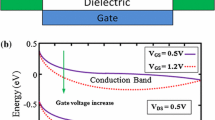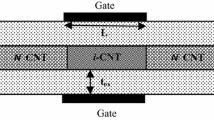Abstract
Carbon nanotube field-effect transistors (CNTFETs) have been studied in recent years as a potential alternative to CMOS devices, because of the capability of ballistic transport. The ambipolar behavior of Schottky barrier CNTFETs limits the performance of these devices. A double gate design is proposed to suppress this behavior. In this structure the first gate located near the source contact controls carrier injection and the second gate located near the drain contact suppresses parasitic carrier injection. To avoid the ambipolar behavior it is necessary that the voltage of the second gate is higher or at least equal to the drain voltage. The behavior of these devices has been studied by solving the coupled Schrödinger-Poisson equation system. We investigated the effect of the second gate voltage on the performance of the device and finally the advantages and disadvantages of these options are discussed.
Similar content being viewed by others
References
A. Javey et al., “Ballistic Carbon Nanotube Field-Effect Transistors,” Letters to Nature, 424(6949), 654 (2003).
R. Martel et al., “Ambipolar Electrical Transport in Semiconducting Single-Wall Carbon Nanotubes,” Physical Review Letters, 87, 256805 (2001).
J. Appenzeller et al., “Field-Modulated Carrier Transport in Carbon Nanotube Transistors,” Physical Review Letters, 89, 126801 (2002).
J. Appenzeller et al., “Field-Modulated Carrier Transport in Carbon Nanotube Transistors,” Physical Review Letters, 89, 106801 (2002).
J. Appenzeller et al., “Tunneling Versus Thermionic Emission in One-Dimensional Semiconductors,” Physical Review Letters, 92, 048301 (2004).
M. Radosavljevic et al., “Drain Voltage Scaling in Carbon Nanotube Transistors,” Appl. Phys. Lett., 83(12), 2435 (2003).
J. Guo et al., “A Numerical Study of Scaling Issues for Schottky Barrier Carbon Nanotube Transistors,” IEEE Trans. Electron Devices, 51(2), 172 (2004).
FETs, “IEEE Trans. Nanotechnology,” 2(3), 181 (2003).
M. Pourfath et al., “Improving the Ambipolar Behavior of Schottky Barrier Carbon Nanotube Field Effect Transistors,” in Proc. ESSDERC (2004), p. 429.
D. John et al., “A Schrödinger-Poisson Solver for Modeling Carbon Nanotube FETs,” in Proc. NSTI Nanotech (2004), p. 65.
Author information
Authors and Affiliations
Corresponding author
Rights and permissions
About this article
Cite this article
Pourfath, M., Ungersboeck, E., Gehring, A. et al. Numerical Analysis of Coaxial Double Gate Schottky Barrier Carbon Nanotube Field Effect Transistors. J Comput Electron 4, 75–78 (2005). https://doi.org/10.1007/s10825-005-7111-z
Issue Date:
DOI: https://doi.org/10.1007/s10825-005-7111-z




